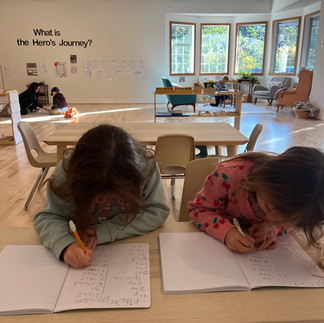Week 7: Choice Words - Badges vs Grades
- Sheryl - Lead Guide
- Oct 19
- 4 min read
At Acton, we believe that each young person is on a Hero’s Journey - that deeply human story of setting out, encountering challenges, mastering skills, and returning transformed. One of the most visible ways we live that out is through the badge system: the moment when a learner earns a badge is not just about completing a task, it’s a visible marker of mastery, of readiness, of stepping fully into their capability.
Contrast this with the all‑too‑common system of grades, tests, and letters (A, B, C, D, F). In the traditional model the child is often locked into a “did I pass?” frame or worse, “how judged am I?” frame. At Acton, we’re doing something subtly and profoundly different: we’re asking children when are you ready? When you truly understand, when you can apply, when you can teach someone else. When you ring the bell and walk over and post the badge on your crest, you aren’t asking “did I do it?” you’re declaring “I’ve mastered this.”
What a Badge Means in Our Studio
In our studios a badge is not given lightly. It is earned: the learner has worked through the body of work, demonstrated the skills, met the clear standards, and is ready to move on. That moment of celebration is important. It is public. It is peer‑recognized. It is joyful. It says: “You’ve done this. You’re ready.” The badge becomes part of the learner’s journey tracker, a visible accumulation of competencies, and a signal that progression is earned (not just administered). It is mastery‑based, not time‑based - not everyone moves on at the end of the session, whether they’re ready or not.
Why This Matters: The Benefits of Badges
Ownership & agency. The learner knows the standard. They know when they are ready. They can push, pause, redo. It aligns with the Acton core “Learn to Learn, Learn to Do, Learn to Be.”
Motivation rooted in mastery, not fear. When badges are visible and celebrated, they provide genuine motivation. This is a very different engine from “I hope I don’t get a D” or “I hope that test doesn’t crush me.”
Mastery, not minimum competence. The badge system says: you don’t move on when the studio schedule says so; you move on when YOU are ready. Learners move at their own pace and don’t move on until they’ve mastered a skill.
Peer recognition & community celebration. The moment is shared. It cultivates pride, responsibility, and aspiration for others: “I want to ring that bell too!” It turns mastery into a social and relational moment, not just a private result.
Clear standards, less ambiguity. At Acton, badges are tied to definite standards. In many grade‑systems, the criteria are fuzzy. "Did I get an A because I memorized facts? Because I wrote a “good” essay (by adult judgement)?" At Acton the criteria are more transparent: the learner, the guide, the peers know what “mastery” looks like, and the badge seals it.
Conventional Grading: Why We Chose a Different Path
In most conventional models, the system looks like this: a teacher sets a test or assignment, children complete it, it is judged, and given a grade (or mark). Later, perhaps, the grade is recorded, averaged, summarized. We see few problems with this model:
Time‑based progression: Whether or not you ‘understood’, you move to the next unit when the schedule says so.
Ranking and comparing: Grades permit ranking, competition, hiding real growth behind curves or averages.
Judgement more than growth: A grade often measures what you did; not necessarily what you learned, whether you can apply it, or whether you can teach it.
Effort hidden: A learner who laboured may get the same grade as one who barely tried (or vice versa), but the standard is static.
Motivation by fear or avoidance: Much of their educational journey becomes “don’t get a bad grade,” “pass the test,” and perhaps most detrimentally, “avoid failure” rather than “become ready, do meaningful work, celebrate.”
Ambiguity of what next step is: A grade of B doesn’t always tell a learner: what is the next target, what do I have to show, where do I go to be ready to move on?
Because of these structural issues, it becomes far too easy for learners to see education as an obstacle rather than a growth journey.
How Badges and Conventional Grades Differ — Side by Side
Why This Matters for Us at Acton Academy Nanaimo
We believe it matters that children feel joy when they master something, that they feel ownership, that they know in their bones: I did this. I am ready. At Acton Nanaimo our daily rhythm (launches, Socratic discussions, goal‑setting, tracker maps, badges, exhibitions) all flow together to reinforce that sense of agency, mastery, and purpose.
Because in the end, our mission is: Find a calling. Change the world. Your child does not need to make it to university (though many Acton heroes do). They need to walk into life with confidence, capacity, and character. A badge isn’t just a reward; it is a signal: You’re ready for your next challenge.
In Summary
Badges at Acton aren’t trivial. They are central. They are celebration of mastery in a community of peers, a visible accumulation of competency, a shift away from the fear‑of‑failure model of conventional grading. At Acton Academy Nanaimo we believe that when children get to earn their signals of readiness, and when they choose to climb the next mountain, then they don’t just learn, they transform. The badge isn’t the end of the story; it’s the echo of the Hero’s journey so far, and the launch pad for what comes next.
"Always bear in mind that your own resolution to succeed is more important than any other."
Abraham Lincoln



























Comments